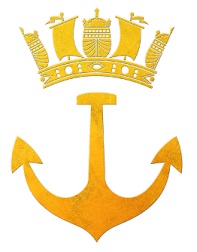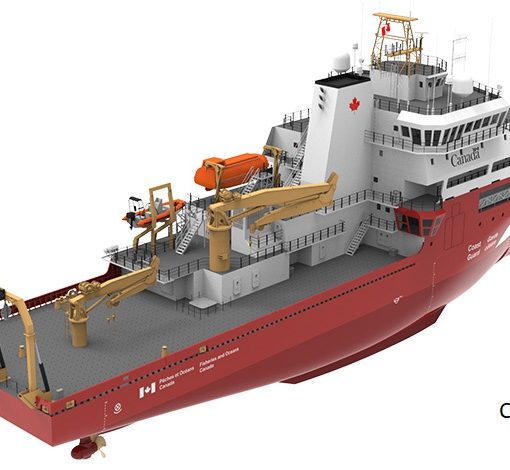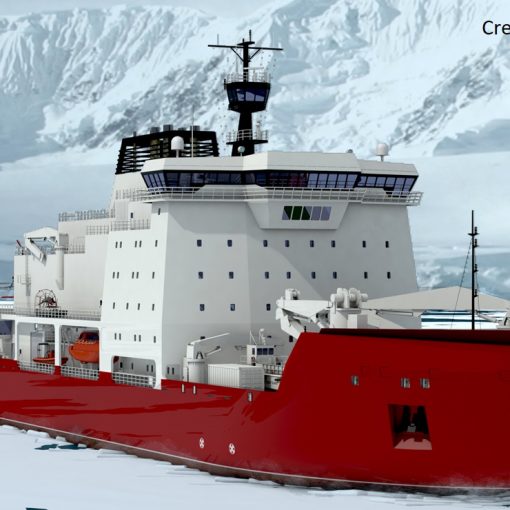By Jose Canadas, 24 September 2023
According to a note released this week in Naval News (1), the Canadian Coast Guard (CCG) plans to revamp its fleet of Air Cushion Vehicles (ACVs), commonly known as hovercraft. These crafts play a crucial role in supporting CCG's operations, from search and rescue (SAR) missions to icebreaking duties, particularly in the St. Lawrence River at the end of winter season.
The decision to modernize these specialized craft underscores their significance in maintaining safe and efficient navigation in Canada's waterways. This upgrade initiative aims not only to enhance their life span with fully modernized systems (e.g. lift and bow thruster system, electrical system, controls and communications) but will also explore the use of innovative power plant technologies to reduce fuel consumption and carbon emissions.
Preserving these hovercraft is crucial not only for their immediate duties but also to safeguard expertise in their operation and maintenance. This specialized craft (and associated knowledge) could prove quite valuable for Arctic operations at some point. By keeping them operational and upgrading their systems, Canada may remain better prepared to address evolving conditions and challenges in the Arctic.




18 thoughts on “Canadian Coast Guard to modernize Hovercraft fleet”
Hi Jose,
Thank you for this.
If only the RCN was able to build on the CCG’s hovercraft expertise to support its operations in the Arctic!
Such an employment would require modifications to the AOPS and preferably additional, specialized warships.
Ubique.
Les
While it looks good on paper the reality is that hovercrafts are unsuitable for the Arctic due to the conditions they may face. If we can guarantee good weather then they probably would be useful but with weather turning bad in mere hours not worth the risk. As the climate in the Arctic changes to greater periods of time without ice then perhaps in the future could be used.
Good morning Retired,
When I suggested that the RCN would benefit from using hovercraft in the Arctic I envisioned their use as ships boats that are unaffected by some amount of sea-ice and also as LCACs that are able to carry landing parties across the water and onto and beyond the shoreline (see CNR 18.1 pp 34-36). Based on the Royal Marines’ experience using LCACs in north Norway I do not believe that such employment should be a problem, except in extreme conditions.
What hovercraft use do you foresee being forestalled by Arctic conditions? And which Arctic conditions specifically?
Ubique.
Les
I have seen examples of hovercrafts used in the Arctic, all of which show benign conditions usually a sunny day on flat ice. In the Arctic often ice is not entirely flat and often razor sharp. Even a “light” hovercraft in my opinion is entirely too large to be placed and launched on a AOPV, some sort of amphibious ship yes but not platforms we currently operate. Even the smaller ones that could be placed on the AOPV and launched successfully are too small in cargo carrying capacity and offer no protection to personnel. If a hovercraft skirt is holed which is most likely to occur, how easy would it be to repair in the Arctic in cold weather? Low temperatures have a detrimental effect on pretty much everything so these proposed machines need to be built with that in mind. These are practical considerations that must be looked at. The conventional landing craft we currently use true cannot travel on ice or inland but way easier to repair than a hovercraft and so far has performed brilliantly. Given the CCG experience in operating hovercrafts and their experience in the Arctic why do you think they also rely on landing craft and helos?
Hi Retired,
Thank you for your insights and thoughts. You raise some very valid considerations. Any plan to employ RCN hovercraft would need to explore them thoroughly before a full-throated commitment was made to such craft.
I assume that the CCG uses boats and helos more than hovercraft because it does not have the same requirements as I envision for the RCN in the Arctic. Do you have any insights on this point?
Ubique.
Les
Well yes any proposed use would have to be studied by the RCN. I can tell you that will most likely never happen as the RCN has more important matters to consider.
The CCG doesn’t use that many hovercrafts. In fact they only use 2 on the EC in the Saint Lawrence for breaking river ice. In the Arctic they use helos and landing craft for personnel and cargo transfers. For the RCN it’s the same.
Reply to Retired RCN of 6 Oct 23
Good morning Retired,
While you are correct that the CCG uses only two hovercraft for icebreaking, it actually has two more in service in its Western Region – Moytel and Siyay I believe. Thus, it has a reservoir of hovercraft expertise and support into which the RCN could tap.
Although you raise important technical issues with regard to the use of hovercraft in the Arctic, I am not convinced that they are unsolvable and automatically preclude all RCN hovercraft use such as found at CNR 18.1 pp 34-36.
Ubique.
Les
Hi, well aware of the CCG expertise and other units in service. I had thought the ones used in anything approaching Arctic conditions and ice were germane to this discussion but yes the CCG do have some experience. That being said, breaking river ice and operating in winter is very different than operating in the Arctic. Given enough money nothing is unsolvable however this is so far down on the priority list for the RCN I would place it below acquiring nuclear submarines to be perfectly honest.
Hi Retired,
Thank you for your comments. As you may have seen from my CNR articles over the years, I see hovercraft as part of a CAF Arctic amphibious capability. To me, such a capability is a vital component of the CAF’s force structure and far more important than nuclear submarines or the 15th, 14th, or even 13th CSC.
Do you see any value in such a capability? Do you see Canada needing to be able to assert and protect its Arctic sovereignty? If your answers to the preceding are No and Yes, how would you see such assertion and protection being done?
Ubique.
Les
Hi, I get this is a interesting capability you are promoting but you may want to ask yourself why the CCG with four hovercraft that they operated for years have not used them in the Arctic even once. The CCG transfers personnel, cargo regularly in the Arctic but utilize the tried and true metal hulled ships’ boats.
If we had the capability or requirement to operate or move large amounts of personnel or equipment then I would say yes let’s investigate this capability thus making this capacity a priority. In the absence of any platform large enough to operate the type of hovercrafts needed any large movement of personnel is going to be by AOPV or JSS when built picking up personnel from somewhere like Iqaluit after being flown in or air dropped. Any significant movement of equipment will be by air or commercial ship much like the way the annual sealift operates. If we had the capability to move hovercrafts it would need to proven without a shadow of a doubt that they can operate effectively and be maintained in the Arctic.
Hi Retired,
I am not aware of the CCG needing to move personnel and equipment to/from the Arctic shoreline, such as I envision in my series of articles. CCG ships in the Arctic tend to work in the water doing icebreaking or scientific work, not as amphibious (land involved) ships. My limited knowledge of their operations tells me that, barring an oil spill, their interactions with shore relate only to crew/personnel changes and some light logistics movements.
Airlanding and air dropping personnel into the Arctic have some serious limitations, starting with the troops’ movement and support once they are on the ground. This is why I argued in a Canadian Army Journal article for the conversion of the army’s non-mechanized infantry battalions into true light infantry units that can provide airborne company groups and marine infantry ones for Arctic operations. The parachutists could be air dropped into an area and then supported by ships (AOPVs at least) with helicopters and additional infantry (as one scenario).
From what I can see of Arctic ship operations during the normal navigation season, simply moving troops and stores to/from ships can be seriously or fully disrupted by sea ice that is moved around by waves and currents (the CBC documentary series “High Arctic Haulers” from 2020 highlights this point well). This is where I see RCN hovercraft operating.
I find it hard to believe that the AOPVs cannot be modified to carry what I called a light hovercraft (such as used by the Royal Marines). This would provide some minimal amphibious capability and would allow the CAF to learn about such operations.
The investment required would be minimal; the ships (AOPVs), troops, and Cyclone (troop lift) helicopters are already in service. What is needed is the will to experiment, some hovercraft to complement the Cyclones, and quite small (in DND terms) sums of money. If nothing else, experimenting would prove that the concept is not good enough, or needs a dedicated amphibious ship(s).
Personally, I fear what is lacking is the vision and the will.
Ubique.
Les
Hello.
When I posted the article my main point was on keeping some knowledge/capability on operating and maintaining hovercrafts in Canada. Once a capability is lost, it may take years to rebuild it. Like Les Mader, I think these type of crafts (but not this specific model) may be useful in the future as part of an amphibious force, being delivered from a mothership, be it a LHD, LPA or LSI(A), including also the ability to operate in the Arctic. Thank you Retired RCN for your insightful inputs on the subject. Still we might consider Arctic operations not only on flat ice but also during the navigable season, in which hovercrafts may reach or sail along the shoreline and “explore” the area faster and further than the conventional (Arctic) landing craft in use by the RCN.
To be clear, even though I agree that nowadays the RCN has some other priorities, let us make an hypothetic approach to a possible future force structure for the RCN. In such a theoretical exercise, my envisioned Navy would operate a small amphibious force, capable to also deploy in the Arctic. Hovercrafts could be very useful assets for reaching specific locations or conducting shoreline and choke points reconnaissance and surveillance, depending on the mission and scenario.
Hi Les, regarding your last comments I will speak about my experience in the Arctic. I have about ten deployments to the Arctic with the RCN and have worked with all manner of stakeholders including the CCG. As a government department they do support research to DRDC, NETE, Canadian Rangers, Canadian Army, navigation aids and all sorts of material that need to be brought to the ship or to shore in the course of their duties. As mentioned, they do crew changes that require personnel and personal affects to be transferred ashore, embark supplies, disembark garbage etc so yes there is a requirement for them to do so that is slightly greater than light logistics. They also could be called upon to support large scale rescue activities in the event of a passenger ship runs aground, I was part of one such exercise and believe me the CCG was there front and center using their landing craft.
You are correct that sea ice moves and could potentially block operations, however that is why the government has assets to break ice and where the CCG comes in. Sometimes it may take an air drop even in difficulty to get troops in place quickly, it would take a ship around 7 days if not longer to get to the Arctic to land troops or equipment. At the same time troops can be supplied by air to give them enough time to allow for proper logistical support. I would like to think if we faced that situation, we would see that coming long before it became an issue. You are correct that we need airborne troops that can operate in the Arctic.
AOPS does not have the room to park a hovercraft as their boat and vehicle deck is too small and sharing it with their payloads and ships boats, this is something you cannot modify, even the crane requirements alone would not make it possible. This is why military hovercrafts are typically launched from landing docks or similar platforms. We do not have the doctrine for such a ship and so far down on the priority list I cannot see it ever happening despite the perceived benefits. We can only dream, right?
It would be more expensive than you think. You would need a platform, even if AOPS were able to be modified you are talking tens of millions of dollars not to mention issues of weight and stability. Troops are a given if you have the room to house them, AOPS are exceedingly small in their extra personnel carrying capability unless ferrying them from somewhere close after they are landed by aircraft. Despite all the hype you will not see a Cyclone anytime soon embarked on an AOPS. We only have so many aircraft, they must be configured to carry troops which is not easy and cannot be done onboard, there is no helo haul down on AOPS and the Cyclone has not been certified for use aboard the class. Everything you are talking about is cost prohibited in a time where the RCN is cutting, not adding capability. If tomorrow, we decided to build ships to use this capability I would say go for it despite their limitations. It is not about vision or will, it is about being practical on a limited budget.
Good morning Retired,
Thank you for sharing your Arctic experience. I readily admit that you have far more hands-on knowledge and experience in this area than me.
We have very different visions of how marine infantry could be used in the Arctic. You seem to envision an administrative or disaster response type scenario. I am arguing for the ability to be able to contain and confront intruders as well. In such cases, using ice breakers to clear paths through sea ice for landing craft may not be tactically feasible. Thus, the need for LCACs.
Even if the AOPVs cannot carry a hovercraft the basic marine infantry experiment could still be carried out. The arguments with regard to the Cyclones seem to me to be excuses for inaction, other than the lack of a haul-down device; ship-Cyclone certification, aircraft modification, and aircraft availability could be addressed if the will existed. None of these three actions would be very expensive, especially compared to the learning and public perception benefits of going forward with them, for at least an experiment.
However, I agree that such actions will not happen, short of a miracle. I do not see the CAF and RCN having the will to try. They seem to be fully mired in the day-to-day to the detriment of thinking ahead.
Ubique.
Les
We have already seen the trying of big, medium and small hovercraft in Canada’s North and the results. The use of a hovercraft means you have to deal with static electrical problems that have fried entire electrical systems on hovercraft in remote areas and another problem that was noticed very quickly was the skirting systems freezing to the ground. The cutting up of skirts and being a quick fix did not work out either.
Take a look back in Canadian Hovercrafting history by a lot of big companies with huge machines – before you look ahead and waste money re-inventing the wheel.
Good morning Leigh,
Thank you for this interesting new (to me) information.
Can you provide references that I can consult to educate myself further?
Ubique.
Les
There are advanced modern hovercraft designs and systems exist. Such as ATASD. It could be scaled 3-4 times in size and made ready to be used in Arctic conditions.
Thank you Roman for this information.
Can you provide links to descriptions of the ATASD?
Ubique.
Les